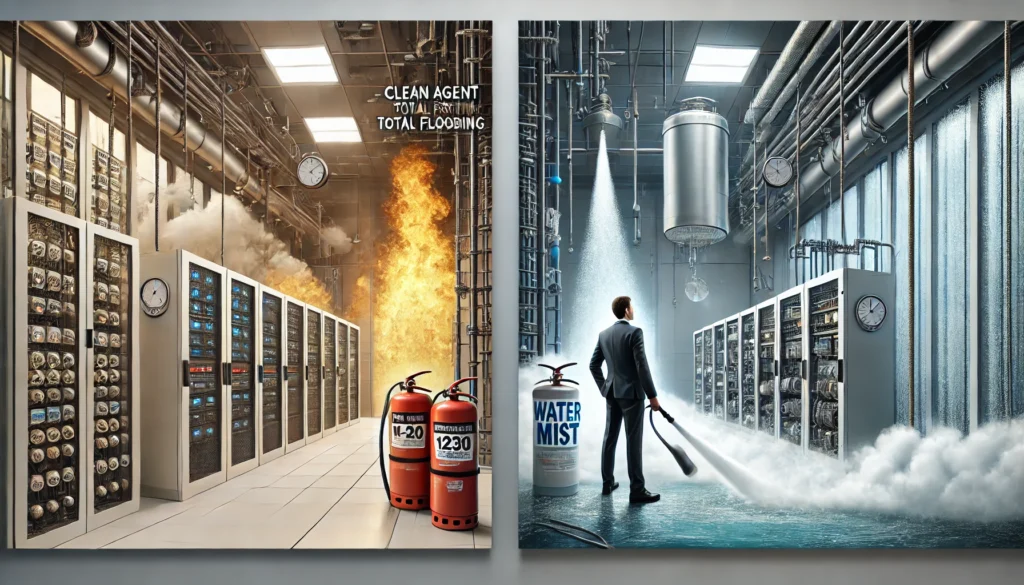Fire suppression systems play a crucial role in protecting lives, assets, and critical infrastructure from devastating fires. Among the various systems available, Total Flooding Systems and Water Mist Systems are two widely used solutions. Each has its strengths and is best suited for specific applications.
This guide provides a detailed comparison of both systems, including their functionality, effectiveness, applications, and key decision factors.
Key Differences Between Total Flooding & Water Mist Systems
| Feature | Total Flooding System | Water Mist System |
|---|---|---|
| Operating Principle | Releases a gas or foam-based suppressant that floods an enclosed space. | Utilizes high-pressure mist nozzles to generate fine water droplets for fire suppression. |
| Suppression Mechanism | Displaces oxygen (gas-based) or creates a chemical reaction (foam-based). | Absorbs heat, reduces flame temperature, and displaces oxygen locally. |
| Best For | Fully enclosed spaces with minimal air exchange. | Open, semi-enclosed areas where water damage is a concern. |
| Fire Classes | Suitable for Class A, B, and C fires (solids, flammable liquids, electrical fires). | Best for Class A and B fires, effective against electrical fires with minimal risk. |
| Water Usage | No water used (gas-based). | Uses up to 90% less water than traditional sprinkler systems. |
| Suppression Agent | Gases: FM-200, Novec 1230, Inergen, CO₂. Foam-based agents. | Fine water mist dispersed at high pressure. |
| Risk to Occupants | CO₂ systems can be hazardous due to oxygen displacement. | Safe for occupied areas, as it does not create a breathable hazard. |
| Water Damage Risk | No water damage (gas-based). | Minimal water damage compared to traditional sprinklers. |
| Installation Complexity | Requires airtight enclosures, proper ventilation, and specialized piping. | Requires high-pressure piping and mist nozzles, no need for airtight sealing. |
| Maintenance Requirements | Regular cylinder pressure checks, leak detection, and testing. | Regular nozzle inspections, pump testing, and pressure monitoring. |
Best Applications for Each System
| Application | Total Flooding System | Water Mist System |
| Data Centers & Server Rooms | Ideal (FM-200, Novec 1230) | Suitable (low-pressure water mist) |
| Transformer & Electrical Rooms | Recommended (Inergen, CO₂) | Suitable (low-conductivity mist) |
| Archives, Libraries, Museums | Best Choice (gas-based, no water damage) | Suitable (fine mist reduces water exposure) |
| Food Processing Plants | Suitable (CO₂ suppression in enclosed areas) | Ideal (safe for food, minimal residue) |
| Oil Refineries & Petrochemical Plants | Recommended (foam-based flooding) | Highly Effective (direct flame suppression) |
| Commercial Kitchens | Not Ideal (gas dissipates quickly) | Best Option (water mist cools grease fires) |
| Hospitals & Healthcare Facilities | Suitable (gas-based for sensitive areas) | Recommended (safe for occupied spaces) |
When to Choose Each Fire Suppression System
Choose a Total Flooding System if:
- The fire hazard is in an enclosed space like server rooms, transformer rooms, and data centers.
- You need zero water damage (ideal for libraries, archives, museums).
- Oxygen displacement or chemical reaction is an effective suppression method.
- Compliance with NFPA 2001 or NFPA 12 is required for clean agent and CO₂ systems.
Choose a Water Mist System if:
- The fire hazard is in an open or semi-enclosed area (kitchens, industrial spaces, public areas).
- Minimal water damage is required but some water is acceptable.
- Heat absorption and localized oxygen displacement work effectively.
- Compliance with NFPA 750 (Water Mist Fire Protection Systems) is necessary.
FAQ
1. Which system is more cost-effective?
Water Mist Systems generally have lower operating costs and maintenance compared to gas-based total flooding systems. However, installation costs depend on system complexity.
2. Do Water Mist Systems cause electrical damage?
No. Fine mist evaporates quickly, preventing water pooling, making it safe for electronics and electrical equipment.
3. Can Total Flooding Systems be used in hospitals?
Yes, but with limitations. Gas-based systems work well in restricted areas like operating rooms, but water mist is safer for patient-occupied spaces.
